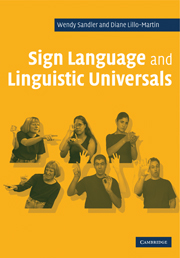Book contents
- Frontmatter
- Contents
- Preface
- Notation conventions
- UNIT I INTRODUCTION
- UNIT II MORPHOLOGY
- UNIT III PHONOLOGY
- 8 Meaningless linguistic elements and how they pattern
- 9 Sequentiality and simultaneity in sign language phonology
- 10 Hand configuration
- 11 Location: feature content and segmental status
- 12 The non-dominant hand in the sign language lexicon
- 13 Movement
- 14 Is there a syllable in sign language?
- 15 Prosody
- 16 Phonology: theoretical implications
- UNIT IV SYNTAX
- UNIT V MODALITY
- References
- Index
13 - Movement
Published online by Cambridge University Press: 05 June 2012
- Frontmatter
- Contents
- Preface
- Notation conventions
- UNIT I INTRODUCTION
- UNIT II MORPHOLOGY
- UNIT III PHONOLOGY
- 8 Meaningless linguistic elements and how they pattern
- 9 Sequentiality and simultaneity in sign language phonology
- 10 Hand configuration
- 11 Location: feature content and segmental status
- 12 The non-dominant hand in the sign language lexicon
- 13 Movement
- 14 Is there a syllable in sign language?
- 15 Prosody
- 16 Phonology: theoretical implications
- UNIT IV SYNTAX
- UNIT V MODALITY
- References
- Index
Summary
All signs have movement in them – either a path made by the hand or hands as they go from one location to another, a change in handshape, a change in orientation, or some combination of these (Wilbur 1987, Stack 1988, Brentari 1990). In the classifier subsystem (introduced in Chapter 5), there is a sizeable inventory of movements, and a rich array of combinatory possibilities, both simultaneous and sequential. In words of the lexicon, the main focus of this chapter, the inventory of path movements is far more limited, and the possibilities for their combination strictly constrained. Yet they are part of the system, not only phonetically, but phonologically and morphologically as well, and many models of sign language phonology treat movement as an important phonological property of signs (e.g., Stokoe 1960, Liddell and Johnson 1989 [1985], Sandler 1989, 1993d, Brentari 1990, 1998, Perlmutter 1992, Wilbur 1993, 1999a). These investigators are in agreement about the importance of movement, but not about the way in which it is integrated into the phonology of sign language, and the following questions remain unresolved: how is movement instantiated in a sign, and how should it be represented in a model of sign language? Do movements constitute a sequential segment type, or do they characterize the sign as a whole? Are they like vowels, carrying the sonority of the sign language syllable?.
- Type
- Chapter
- Information
- Sign Language and Linguistic Universals , pp. 196 - 215Publisher: Cambridge University PressPrint publication year: 2006

